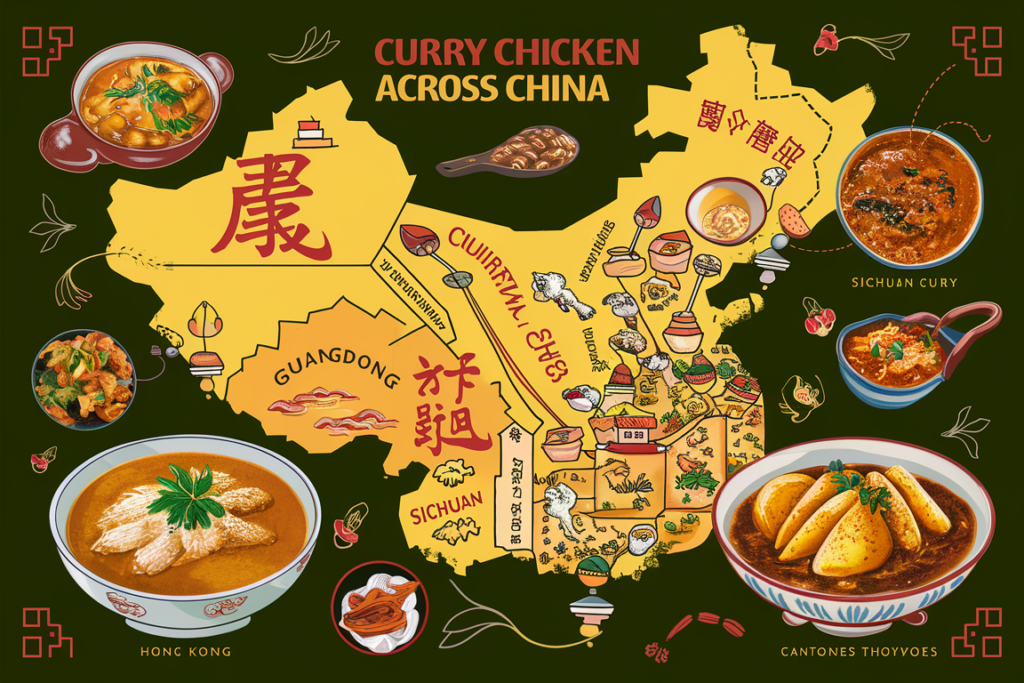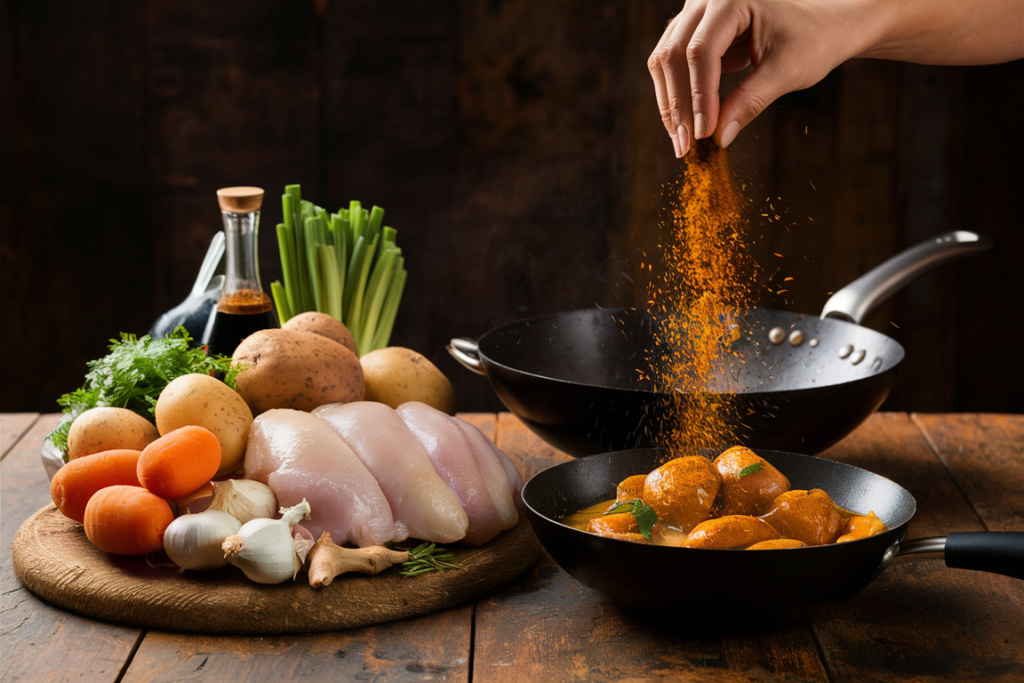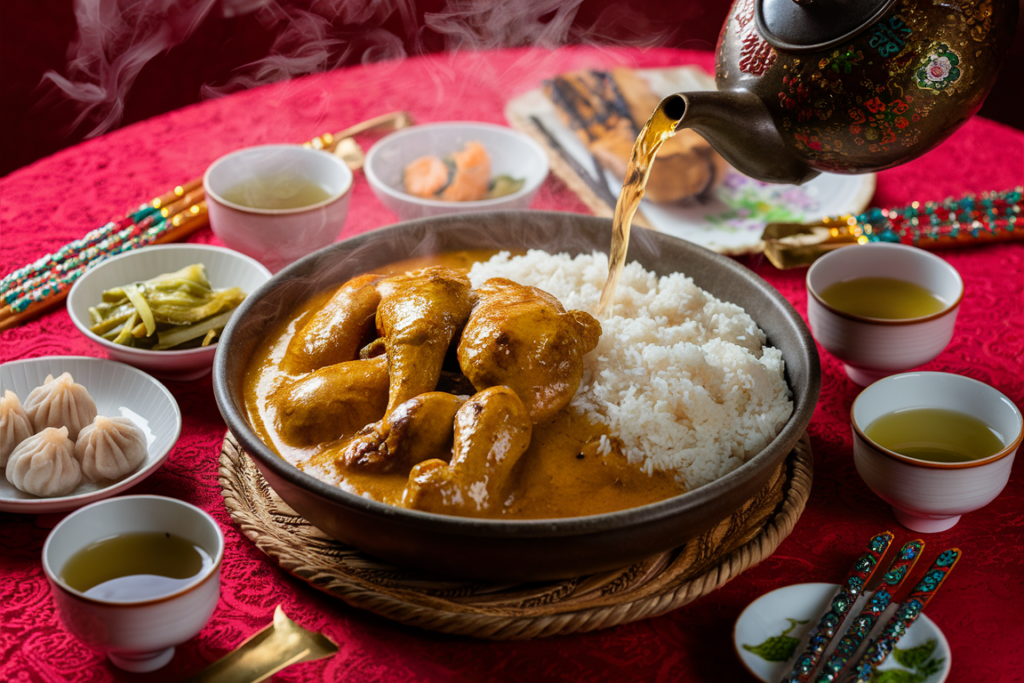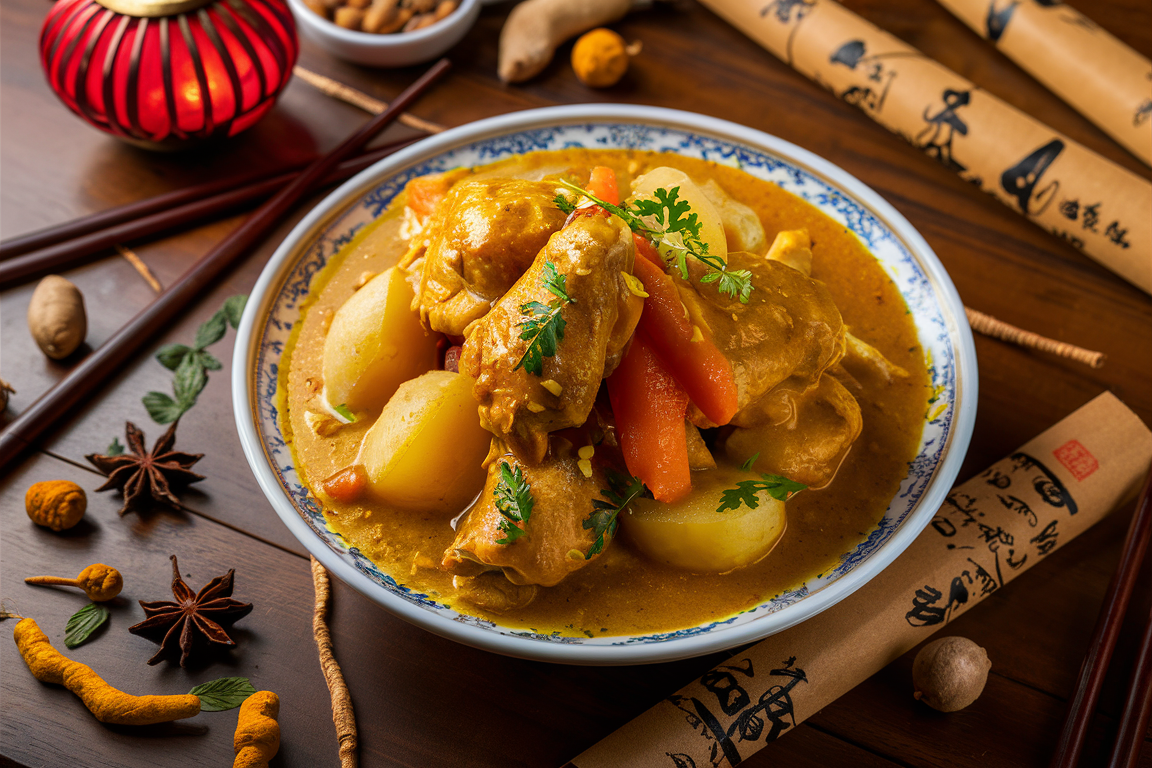Part 1: Introduction to Curry Chicken in Chinese Cuisine
Curry chicken holds a unique place in Chinese cuisine, blending the aromatic warmth of spices with the adaptability of Chinese cooking techniques. While curry is traditionally associated with Indian or Southeast Asian cuisines, its introduction into Chinese kitchens has resulted in an array of regional adaptations that showcase the Chinese flair for culinary innovation.
The dish has become a staple in many Chinese households and restaurants, offering a taste that bridges cultural boundaries. From the bustling street markets of Hong Kong to the rural kitchens of Guangdong, Chinese-style curry chicken varies in flavor and presentation.
Origins and Cultural Significance
Influence of Southeast Asian Cuisines
Curry’s entry into Chinese cuisine can be traced back to the historical trade routes between China and Southeast Asia. Merchants traveling along the ancient spice routes brought exotic ingredients such as turmeric, cumin, and coriander. These spices laid the foundation for a Chinese interpretation of curry dishes, often milder and less spicy compared to their Southeast Asian counterparts.
Regions like Guangdong and Fujian, known for their proximity to trade hubs, were among the first to experiment with curry flavors. The Hainanese influence, a result of Chinese diaspora in Malaysia and Singapore, further enriched the way curry chicken evolved in Chinese kitchens.

Key Differences Between Chinese and Indian Curry Chicken
While both Indian and Chinese curry chicken rely heavily on spices, their preparation, flavor profiles, and accompanying ingredients differ significantly.
- Flavor Profile: Indian curries often emphasize bold, spicy flavors with a creamy base of yogurt or cream. In contrast, Chinese curry chicken is typically lighter, with a broth-based sauce thickened using starch.
- Spices Used: Indian recipes feature garam masala, cardamom, and cloves. Chinese versions rely on curry powder blends that are pre-mixed with subtle additions like star anise and five-spice powder.
- Cooking Techniques: Indian curries are slow-cooked, allowing the flavors to develop over time, while Chinese curry chicken may be stir-fried and then simmered for a quicker cooking process.
Popular Variations Across Chinese Provinces
Cantonese Curry Chicken
In Guangdong province, curry chicken features a mild and savory sauce, often paired with soft potatoes and onions. This version is common in dim sum restaurants and Chinese home kitchens.
Hong Kong-Style Curry Chicken
Hong Kong’s version of curry chicken integrates influences from British colonial cuisine, often including coconut milk for a rich, creamy texture. It’s a perfect representation of East meets West flavors.
Sichuan Curry Chicken
The bold and spicy flavors of Sichuan cuisine come alive in their interpretation of curry chicken. Adding Sichuan peppercorns gives the dish a characteristic numbing heat, setting it apart from other versions.
How Curry Was Adapted in Chinese Cooking Over Time
The adaptation of curry in Chinese cooking showcases the versatility of Chinese chefs. Initially, curry was introduced in coastal cities like Shanghai and Hong Kong, where exposure to foreign cuisines was more common. Over time, chefs modified the flavors to suit local palates by:
- Reducing the heat of traditional curries to create a milder taste profile.
- Incorporating Chinese cooking staples like soy sauce and Shaoxing wine.
- Using cornstarch to thicken the sauce, creating the glossy texture characteristic of Chinese dishes.
Modern adaptations continue to evolve, with fusion recipes incorporating global ingredients like cheese or Japanese curry roux.
Common Ingredients in Chinese-Style Curry Chicken
Proteins and Vegetables
- Chicken: Bone-in cuts like thighs or drumsticks are preferred for their rich flavor.
- Potatoes and Carrots: These vegetables are a staple, adding natural sweetness and heartiness to the dish.
- Onions: Onions enhance the aroma and sweetness of the curry.
Spices and Seasonings
- Chinese Curry Powder: A blend of turmeric, cumin, coriander, and additional regional spices.
- Soy Sauce: Adds depth and umami.
- Garlic and Ginger: These aromatics form the base of most Chinese curry chicken recipes.
Role of Spices in Chinese Curry Dishes
Spices play a crucial role in elevating the dish. Unlike Indian curries, which may use individual spices in raw or roasted forms, Chinese curry relies on pre-mixed curry powder. The addition of star anise and cinnamon provides a sweet undertone, while Sichuan peppercorns may add heat and numbness in regional variations.
Cooking Techniques Unique to Chinese Curry Chicken
Chinese cooking emphasizes quick preparation without compromising on flavor. Techniques include:
- Stir-Frying: Aromatics like garlic and ginger are stir-fried to release their fragrance before adding curry powder.
- Simmering: Once the chicken and vegetables are added, the dish is simmered to allow the flavors to meld.
- Thickening with Cornstarch: This method creates a smooth, glossy sauce, distinct from cream-based curries.
Fusion Curry Chicken Dishes in Modern Chinese Restaurants
In today’s culinary world, fusion dishes are becoming increasingly popular. Modern Chinese restaurants are reinventing curry chicken by:
- Adding cheese to create a baked curry chicken casserole.
- Combining Japanese-style curry with Chinese flavors for a unique twist.
- Experimenting with plant-based proteins to cater to vegetarian diners.
Part 2: Step-by-Step Guide to Making Authentic Chinese Curry Chicken
Essential Ingredients to Gather
To prepare authentic Chinese curry chicken, you’ll need a mix of fresh ingredients and pantry staples commonly found in Chinese kitchens. Here’s what you’ll need:
- Chicken: Bone-in thighs or drumsticks for maximum flavor.
- Vegetables: Potatoes, carrots, and onions, diced into bite-sized pieces.
- Curry Powder: A Chinese-style blend that is mild and fragrant.
- Seasonings: Soy sauce, oyster sauce, sugar, and salt.
- Aromatics: Garlic, ginger, and green onions.
- Broth: Chicken broth or water to create the curry sauce.
- Cornstarch Slurry: A mix of cornstarch and water to thicken the sauce.

Optional ingredients like coconut milk or Sichuan peppercorns can be added to adjust the flavor profile.
Preparing the Chicken for the Dish
Proper preparation ensures tender and flavorful chicken:
- Marination: Marinate the chicken pieces in soy sauce, ginger, and a dash of curry powder for at least 30 minutes. This step infuses the chicken with layers of flavor.
- Blanching (Optional): Some Chinese recipes recommend blanching the chicken briefly in boiling water to remove impurities and excess fat.
Techniques for Creating a Rich and Flavorful Curry Sauce
The sauce is the heart of any curry chicken dish. Follow these steps for a perfectly balanced sauce:
- Stir-Fry Aromatics: Heat oil in a wok or large pan and stir-fry garlic, ginger, and onions until fragrant.
- Toast the Curry Powder: Add the curry powder to the aromatics and stir for 1-2 minutes to release its aroma.
- Deglaze the Pan: Pour in chicken broth and scrape the bottom of the pan to incorporate all the flavors.
- Simmer: Add the marinated chicken, potatoes, and carrots to the pan. Cover and simmer until the chicken is tender and the vegetables are cooked.
- Thicken the Sauce: Stir in the cornstarch slurry to achieve the desired consistency.
Tips for Balancing Spices and Flavors in Chinese Curry
Chinese curry chicken is all about balance:
- For a richer sauce, add a splash of coconut milk.
- Adjust the sweetness with a teaspoon of sugar, especially if the curry powder is too strong.
- Add a touch of soy sauce or salt for more umami.
Regional Recipes: Hong Kong-Style Curry Chicken
Hong Kong’s version of curry chicken is a favorite in cha chaan tengs (local diners).
Ingredients
- Chicken (thighs or drumsticks)
- Potatoes, carrots, and onions
- Coconut milk (optional)
- Chinese curry powder
- Soy sauce and oyster sauce
- Chicken broth
- Cornstarch slurry
Instructions
- Marinate the chicken with soy sauce, ginger, and a dash of oyster sauce.
- Stir-fry onions and aromatics, then add curry powder and toast.
- Deglaze the pan with chicken broth, and stir in coconut milk.
- Simmer with vegetables and chicken until fully cooked.
- Serve over steamed rice or egg noodles.
Variations Using Coconut Milk and Other Regional Ingredients
Coconut milk is a common addition in southern Chinese curry chicken recipes, offering a creamy texture.
Other regional twists include:
- Spicy Sichuan Curry: Add chili oil and Sichuan peppercorns.
- Cantonese Sweet Curry: Incorporate a bit of sugar or condensed milk for sweetness.
- Hakka Style: Use fermented tofu or salted fish for a bold umami punch.
Vegetarian Alternatives and Substitutes
For a vegetarian twist:
- Replace chicken with tofu or seitan.
- Substitute chicken broth with vegetable stock.
- Use plant-based coconut milk or omit for a lighter sauce.
Time-Saving Tips for Cooking Curry Chicken on a Busy Schedule
If you’re short on time:
- Use a pressure cooker or Instant Pot to reduce cooking time by half.
- Pre-cut vegetables and marinate chicken overnight.
- Opt for store-bought curry powder blends or ready-made curry paste.
Presentation Tips: Plating Chinese Curry Chicken Like a Pro
Make your curry chicken dish visually appealing with these plating tips:
- Serve the curry in a shallow bowl with a side of steamed rice shaped into a neat dome.
- Garnish with chopped green onions or cilantro for color and freshness.
- Pair with a small plate of pickled vegetables to balance the richness of the curry.
Part 3: Serving Suggestions and Pairings
Ideal Side Dishes for Chinese Curry Chicken

Pairing the right side dishes with curry chicken enhances the dining experience and balances the dish’s richness. Popular accompaniments include:
- Steamed White Rice: The simplicity of jasmine rice complements the robust flavors of the curry.
- Fried Rice: Add eggs, scallions, and soy sauce for a richer alternative.
- Steamed Buns (Mantou): Perfect for soaking up the flavorful curry sauce.
- Pickled Vegetables: Light and tangy pickles help cleanse the palate between bites.
For a more indulgent meal, serve Chinese curry chicken alongside crispy spring rolls or pan-fried dumplings.
Traditional vs. Modern Serving Styles
Traditional Style:
- Served family-style in a large bowl.
- Accompanied by steamed rice or noodles, with everyone sharing from the same dish.
Modern Style:
- Presented individually plated with artistic garnishes.
- Often paired with fusion sides like naan bread or quinoa for an innovative twist.
Popular Beverages to Pair with Curry Chicken
Choosing the right beverage is key to enhancing the flavors of curry chicken. Some excellent pairings include:
- Green Tea: Its mild astringency cleanses the palate and balances the richness of the curry.
- Jasmine Tea: Offers floral undertones that complement the spices.
- Beer: A light lager or wheat beer refreshes and cuts through the curry’s heat.
- Milk Tea: Popular in Hong Kong, it provides a creamy sweetness that harmonizes with the dish.
Best Rice Varieties to Serve with Chinese Curry
The type of rice you serve can elevate your curry chicken meal:
- Jasmine Rice: The go-to option for its fragrant aroma and fluffy texture.
- Sticky Rice: Ideal for soaking up thick curry sauces.
- Brown Rice: A healthier alternative that adds a nutty flavor.
Nutritional Benefits of Curry Chicken in Chinese Cuisine
Breakdown of Key Nutrients
Curry chicken is not only flavorful but also nutrient-dense. A standard serving provides:
- Protein: From the chicken, supporting muscle growth and repair.
- Vitamin A: Found in carrots, crucial for eye health.
- Potassium: From potatoes, aiding in fluid balance and nerve function.
- Antioxidants: From spices like turmeric and garlic, reducing inflammation.
Health Benefits of Spices Used in Chinese Curry
Chinese curry incorporates spices with numerous health benefits:
- Turmeric: Contains curcumin, known for its anti-inflammatory and antioxidant properties.
- Ginger: Aids digestion and reduces nausea.
- Garlic: Supports heart health and boosts the immune system.
- Star Anise: Offers antimicrobial properties and enhances respiratory health.
Low-Calorie Variations for a Healthier Dish
For a lighter version of curry chicken:
- Replace coconut milk with almond milk or skip it entirely for a broth-based curry.
- Use skinless chicken breasts instead of thighs or drumsticks.
- Add more vegetables like bell peppers, zucchini, or spinach to boost fiber content.
Curry Chicken’s Role in Chinese Celebrations and Festivals
Popular Occasions for Serving Curry Chicken
Curry chicken often appears during:
- Family Gatherings: Its warm and hearty flavors make it a comforting centerpiece.
- Lunar New Year: Symbolizing wealth and prosperity due to its golden hue.
- Wedding Banquets: Sometimes served as a fusion dish reflecting modern culinary trends.
Symbolic Meanings of Ingredients Used in Curry Dishes
Each ingredient in curry chicken carries a symbolic meaning in Chinese culture:
- Chicken: Represents unity and prosperity.
- Potatoes: Symbolize nourishment and a strong foundation.
- Golden Curry Sauce: Associated with wealth and good fortune.
Stories and Folklore Associated with Curry Chicken in Chinese Culture
There are several folktales surrounding the origins of curry chicken in Chinese cuisine. One popular story recounts how a traveling merchant introduced curry spices to a Guangdong chef, who adapted the dish to suit local tastes. Over time, this fusion became a cherished recipe passed down through generations.
FAQs
1. What makes Chinese curry chicken different from other curries?
Chinese curry chicken is typically milder, less spicy, and features a starch-thickened sauce with ingredients like soy sauce and oyster sauce.
2. Can I make Chinese curry chicken vegetarian?
Yes, substitute the chicken with tofu, mushrooms, or seitan, and use vegetable broth instead of chicken stock.
3. What is the best curry powder for Chinese curry chicken?
Look for Chinese-style curry powder blends, often labeled as “mild curry powder” in Asian grocery stores.
4. Can I freeze leftover curry chicken?
Yes, it freezes well. Store in an airtight container for up to three months.
5. What type of rice pairs best with Chinese curry chicken?
Jasmine rice is the most traditional choice, but sticky or brown rice also works well.
6. How do I thicken Chinese curry sauce?
A cornstarch slurry (1:1 ratio of cornstarch to water) is the easiest way to thicken the sauce.
7. Is Chinese curry chicken spicy?
Typically, it is mild, but you can adjust the heat by adding chili peppers or Sichuan peppercorns.
8. What are some common vegetables in Chinese curry chicken?
Potatoes, carrots, and onions are staples, but you can also add bell peppers or peas.
9. Can I use curry paste instead of curry powder?
Yes, but the flavor may be stronger. Adjust the quantity to taste.

